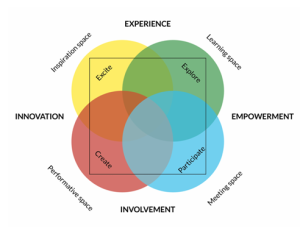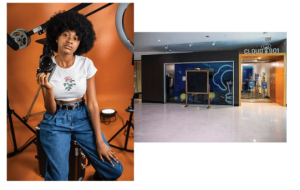The modern library has undergone a profound transformation. Once seen merely as a warehouse for books, it has now evolved into a vibrant, dynamic space that fosters connections between people, ideas, and information. The library of today is no longer just about passive consumption; it is an interactive ecosystem that encourages engagement, creativity, and collaboration. This shift is beautifully captured by Skot-Hansen (2017), who outlines the concept of four key spaces that shape a modern library: the inspirational space, where personal growth and reflection take place; the learning space, which encourages discovery and education; the meeting space, designed for collaboration and community-building; and the performative space, where creativity and innovation come to life.

Together, these spaces form what can be described as a hyperlinked environment, or interconnected world, where individuals are able to engage with a diverse range of information, experiences, and people. This concept is more than just a buzzword in library science; it represents a fundamental shift in how we learn and interact with the world around us. A hyperlinked environment fosters active participation, allowing individuals to both absorb knowledge and contribute their own insights. In such an environment, learning becomes a dynamic, co-creative process that drives cultural growth and collective development.
Take, for example, the Benjamin L. Hooks Central Library in Memphis, Tennessee. This institution is a shining example of how a library can foster a hyperlinked community. The library’s Cloud901 recording studio offers teenagers the opportunity to record music, produce films, and engage with the digital arts in a meaningful way (Grant, 2021). Here, technology plays a key role in providing access to state-of-the-art tools for creation. However, the real power of Cloud901 lies not just in the technology itself, but in the relationships and connections that it facilitates. Teenagers are not simply consuming content; instead, they are actively contributing to the creation of culture and community.

In a hyperlinked environment like this, technology serves as a bridge rather than an isolating force. It is not just about the tools that users have access to, but the way those tools enable new connections and interactions. Every project created in Cloud901 adds a new link to the larger web of community learning. Librarians here are mentors guiding young people to connect with each other, their communities, and the world of ideas. The space becomes an active conduit for collaboration, co-creation, and shared growth.
The concept of hyperlinked environments signals a shift in how we think about education and community engagement. Libraries, once thought of as quiet, solitary spaces, are now at the heart of a vibrant, participatory culture where individuals are both consumers and creators of knowledge. The example of Cloud901 shows us that when technology and human connection are thoughtfully integrated, powerful things can happen.
As we move forward, it is important for libraries and other community spaces to continue embracing the idea of the hyperlinked environment. Whether you are a librarian, educator, or learner, we all have a role to play in building these networks of connection. So, what is your next link? How can you contribute to this interconnected web of creativity and learning in your community?
References:
Grant, R. (2021, November). How memphis created the nation’s most innovative public library. Smithsonian Magazine. https://www.dropbox.com/scl/fi/3g4juvioz86g1m2uj529i/How-Memphis-Created-the-Nation-s-Most-Innovative-Public-Library-Innovation-Smithsonian-Magazine.pdf?rlkey=25yzrxk37civvks7bg6hwaafs&e=1&dl=0
Skot-Hansen, D. (2017, August). Library development: From collection to connection. University of Copenhagen.
@itschelsea This is so good: “Whether you are a librarian, educator, or learner, we all have a role to play in building these networks of connection. ”
I like this idea and how you illustrate that each role is important for the formula of a successful library space to work. The four spaces model is like a blueprint for that.